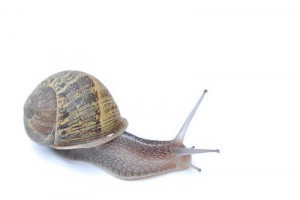Snail Sizes
The maximum size of the snail is 15 inches (39 cm) in the case of the Giant African  Snail. It can weigh up to 2 lbs. if the sea snails are included, one of the biggest snails would be Syrinx aruanus, which can attain a length of 91 cm. The animal can weigh up to 40 lbs (18 kg).
Snail. It can weigh up to 2 lbs. if the sea snails are included, one of the biggest snails would be Syrinx aruanus, which can attain a length of 91 cm. The animal can weigh up to 40 lbs (18 kg).
Classification
The word snail is applied to virtually every animal in the molluscan Gastropoda class that possesses coiled shells. These shells appear when they become adults. Colloquially, the term is employed for land snails, freshwater snails and sea snails.
Distribution
The size of the snail does not affect its ability to adapt and live in different places. The snail is found in various locations like deserts, ditches and the depths of the sea. Many people are familiar with land snails.
However these are actually the minority. Most of the snails in existence are marine-based. The marine snails have a greater biomass and are much more varied. There are also some snails that can be found in the freshwaters.
Diet
Most of the snails are herbivores, but some are carnivores and others omnivores.
Types
The snails that respire belong to the Pulmonata group. The types that have gills make up the paraphyletic cluster. Rather than the size, the taxonomy is determined by the gills.
There are also snails equipped with gills and lungs. These can be found in snails on land and sea. Majority of the snails have tooth-like features on the radula. This is used by the snail to take food apart.
Slugs
The slugs are snails without or a very small shell. Aside from the absence of the shell, there is very little difference between the two. The size of the snail is also similar to the slug. However, the slug is much faster than the snail.
Because the slug doesn’t have a shell, it is able to squeeze and go to places otherwise inaccessible. The slug can often be seen below stone slabs and loose bark. The slug is also found at wood boards.
Snails as Food
Sea, freshwater and land snails are edible. In many countries, the snail is part of the cuisine and served in numerous ways.
Other Facts about the Snail
The lifespan differs among the species. Some Helix snails can live for 3 years, while the Achatinidae snails have an average lifespan of 5 years. Captive snails live for much longer, lasting 10 to 15 years.
There are also some snails that can live for 30 years. Their diet consists of algae, vegetables, leaves, soft bark and various garden plants. Sea snails on the other hand, eat plankton and other small creatures.
The land snail’s predators include caterpillars, leeches and ground beetles. Some freshwater fish feed on sea snails.The size of the snail does not have any bearing on its taste.
However, any wild snail used as food must be cooked thoroughly. Otherwise it may cause meningitis. This can happen because the undercooked snail can contain a parasite.





